POSS and PAG Dual-Containing Chemically Amplified Photoresists by RAFT Polymerization for Enhanced Thermal Performance and Acid Diffusion Inhibition
Abstract
:1. Introduction
2. Experimental Section/Methods
2.1. Materials
2.2. Synthesis of Photoacid Generators TPS-SS
2.3. Synthesis of POSS-MA
2.4. Synthesis of the Copolymer PTBM by RAFT Polymerization
2.5. Photoresist Formulation and Exposure Testing
2.6. Characterization
3. Results and Discussion
3.1. RAFT Polymerization Kinetics
3.2. RAFT Agent Removal
3.3. 1H NMR, FT-IR and UV-Vis Analysis of Polymers
3.4. Thermal Properties of Polymers
3.5. Exposure Testing of Photoresist Copolymer
3.5.1. FT-IR Analysis before and after Exposure
3.5.2. Lithographic Evaluation
4. Conclusions
Author Contributions
Funding
Institutional Review Board Statement
Informed Consent Statement
Data Availability Statement
Conflicts of Interest
References
- Chang, S.; Yang, J.-H.; Chien, J.-H.; Lee, Y.-D. Synthesis of a novel alkaline-developable photosensitive copolymer based on MMA, MAA, SM, and 2-HEMA-grafted GMA copolymer for an innovative photo-imageable dry-peelable temporary protective plastisol. J. Polym. Res. 2013, 20, 115. [Google Scholar] [CrossRef]
- Singh, V.; Satyanarayana, V.S.V.; Sharma, S.K.; Ghosh, S.; Gonsalves, K.E. Towards novel non-chemically amplified (n-CARS) negative resists for electron beam lithography applications. J. Mater. Chem. C 2014, 2, 2118–2122. [Google Scholar] [CrossRef]
- Li, H.; Liu, J.; Zheng, X.; Ji, C.; Mu, Q.; Liu, R.; Liu, X. Synthesis of chemically amplified photoresist polymer containing four (Meth)acrylate monomers via RAFT polymerization and its application for KrF lithography. J. Polym. Res. 2016, 23, 102. [Google Scholar] [CrossRef]
- Lee, C.-K.; Hwang, F.-H.; Chen, C.-C.; Chang, C.-L.; Cheng, L.-P. Preparation and characterization of nanosilica-filled color resist. Adv. Polym. Technol. 2012, 31, 163–171. [Google Scholar] [CrossRef]
- Accoto, C.; Qualtieri, A.; Pisanello, F.; Ricciardi, C.; Pirri, C.F.; Vittorio, M.D.; Rizzi, F. Two-Photon Polymerization Lithography and Laser Doppler Vibrometry of a SU-8-Based Suspended Microchannel Resonator. J. Microelectromech. Syst. 2015, 24, 1038–1042. [Google Scholar] [CrossRef]
- Ito, H. Chemical amplification resists: History and development within IBM. IBM J. Res. Dev. 2000, 44, 119–130. [Google Scholar] [CrossRef]
- Ito, H.; Willson, C.G. Chemical amplification in the design of dry developing resist materials. Polym. Eng. Sci. 1983, 23, 1012–1018. [Google Scholar] [CrossRef]
- Ito, H. Chemical amplification resists: Inception, implementation in device manufacture, and new developments. J. Polym. Sci. Part A Polym. Chem. 2003, 41, 3863–3870. [Google Scholar] [CrossRef]
- Itani, T.; Hashimoto, S.; Yamana, M.; Samoto, N.; Kasama, K. A study of dissolution characteristics and acid diffusion in chemically amplified DUV resist. Microelectron. Eng. 1998, 41, 363–366. [Google Scholar] [CrossRef]
- Reichmanis, E.; Houlihan, F.M.; Nalamasu, O.; Neenan, T.X. Chemical amplification mechanisms for microlithography. Chem. Mater. 1991, 3, 394–407. [Google Scholar] [CrossRef]
- Ito, H. Chemical Amplification Resists for Microlithography. In Microlithography Molecular Imprinting; Springer: Berlin/Heidelberg, Germany, 2005; pp. 37–245. [Google Scholar]
- Przybilla, K.J.; Roeschert, H.; Spiess, W.; Eckes, C.; Chatterjee, S.; Khanna, D.N.; Pawlowski, G.; Dammel, R.R. Progress in DUV resins. Proc. SPIE 1991, 1466, 174–187. [Google Scholar]
- Prabhu, V.M.; Kang, S.; VanderHart, D.L.; Satija, S.K.; Lin, E.K.; Wu, W.-L. Photoresist Latent and Developer Images as Probed by Neutron Reflectivity Methods. Adv. Mater. 2011, 23, 388–408. [Google Scholar] [CrossRef]
- Guo, Y.; Hill, D.J.T.; Whittaker, A.K.; Jack, K.S.; Peng, H. Terpolymerization of Styrenic Photoresist Polymers: Effect of RAFT Polymerization on the Compositional Heterogeneity. Macromolecules 2015, 48, 3438–3448. [Google Scholar] [CrossRef]
- Poliakov, P.; Blomme, P.; Pret, A.V.; Corbalan, M.M.; Gronheid, R.; Verkest, D.; Houdt, J.V.; Dehaene, W. Trades-off between lithography line edge roughness and error-correcting codes requirements for NAND Flash memories. Microelectron. Reliab. 2012, 52, 525–529. [Google Scholar] [CrossRef]
- Gogolides, E.; Constantoudis, V.; Patsis, G.P.; Tserepi, A. A review of line edge roughness and surface nanotexture resulting from patterning processes. Microelectron. Eng. 2006, 83, 1067–1072. [Google Scholar] [CrossRef]
- Patsis, G.P.; Gogolides, E. Effects of model polymer chain architectures of photo-resists on line-edge-roughness: Monte Carlo simulations. J. Phys. Conf. Ser. 2005, 10, 389. [Google Scholar] [CrossRef]
- Kang, S.; Vogt, B.D.; Wu, W.-l.; Prabhu, V.M.; VanderHart, D.L.; Rao, A.; Lin, E.K.; Turnquest, K. Characterization of Compositional Heterogeneity in Chemically Amplified Photoresist Polymer Thin Films with Infrared Spectroscopy. Macromolecules 2007, 40, 1497–1503. [Google Scholar] [CrossRef]
- Sohn, H.-S.; Cha, S.-H.; Lee, W.-K.; Kim, D.-G.; Yun, H.-J.; Kim, M.-S.; Kim, B.-D.; Kim, Y.-H.; Lee, J.-W.; Kim, J.-S.; et al. Synthesis of ArF photoresist polymer composed of three methacrylate monomers via reversible addition-fragmentation chain transfer (RAFT) polymerization. Macromol. Res. 2011, 19, 722–728. [Google Scholar] [CrossRef]
- Otsu, T.; Yoshida, M.; Tazaki, T. A model for living radical polymerization. Die Makromol. Chem. Rapid Commun. 1982, 3, 133–140. [Google Scholar] [CrossRef]
- Otsu, T.; Yoshida, M. Role of initiator-transfer agent-terminator (iniferter) in radical polymerizations: Polymer design by organic disulfides as iniferters. Die Makromol. Chem. Rapid Commun. 1982, 3, 127–132. [Google Scholar] [CrossRef]
- Kato, M.; Kamigaito, M.; Sawamoto, M.; Higashimura, T. Polymerization of Methyl Methacrylate with the Carbon Tetrachloride/Dichlorotris- (triphenylphosphine)ruthenium(II)/Methylaluminum Bis(2,6-di-tert-butylphenoxide) Initiating System: Possibility of Living Radical Polymerization. Macromolecules 1995, 28, 1721–1723. [Google Scholar] [CrossRef]
- Wieberger, F.; Forman, D.C.; Neuber, C.; Gröschel, A.H.; Böhm, M.; Müller, A.H.E.; Schmidt, H.-W.; Ober, C.K. Tailored star-shaped statistical teroligomers viaATRP for lithographic applications. J. Mater. Chem. 2012, 22, 73–79. [Google Scholar] [CrossRef]
- Chen, H.; Chen, L.; Wang, C.; Qu, R. Atom transfer radical polymerization using activators regenerated by electron transfer of acrylonitrile in 1-(1-ethoxycarbonylethyl)-3-methylimidazolium hexafluorophospate. J. Polym. Sci. Part A Polym. Chem. 2011, 49, 1046–1049. [Google Scholar] [CrossRef]
- Fukukawa, K.-i.; Zhu, L.; Gopalan, P.; Ueda, M.; Yang, S. Synthesis and Characterization of Silicon-Containing Block Copolymers from Nitroxide-Mediated Living Free Radical Polymerization. Macromolecules 2005, 38, 263–270. [Google Scholar] [CrossRef]
- Lai, J.T.; Filla, D.; Shea, R. Functional Polymers from Novel Carboxyl-Terminated Trithiocarbonates as Highly Efficient RAFT Agents. Macromolecules 2002, 35, 6754–6756. [Google Scholar] [CrossRef]
- Chong, Y.K.; Moad, G.; Rizzardo, E.; Skidmore, M.A.; Thang, S.H. Reversible Addition Fragmentation Chain Transfer Polymerization of Methyl Methacrylate in the Presence of Lewis Acids: An Approach to Stereocontrolled Living Radical Polymerization. Macromolecules 2007, 40, 9262–9271. [Google Scholar] [CrossRef]
- Luo, Y.; Liu, X. Reversible addition–fragmentation transfer (RAFT) copolymerization of methyl methacrylate and styrene in miniemulsion. J. Polym. Sci. Part A Polym. Chem. 2004, 42, 6248–6258. [Google Scholar] [CrossRef]
- Moad, G.; Rizzardo, E.; Thang, S.H. Living Radical Polymerization by the RAFT Process. Aust. J. Chem. 2005, 58, 379–410. [Google Scholar] [CrossRef]
- Zheng, X.; Ji, C.; Zeng, Q.; Liu, J.; Liu, R.; Mu, Q.; Liu, X. Synthesis of novel copolymer based on precipitation polymerization and its application in positive-tone photoresist. J. Polym. Res. 2017, 24, 198. [Google Scholar] [CrossRef]
- Zhang, Y.; Wu, H.; Guo, Y.-D.; Yang, Y.-B.; Yu, Q.; Liu, J.-G.; Wu, B.-H.; Lv, F.-Z. Atomic Oxygen-Resistant Polyimide Composite Films Containing Nanocaged Polyhedral Oligomeric Silsesquioxane Components in Matrix and Fillers. Nanomaterials 2021, 11, 141. [Google Scholar] [CrossRef]
- Lakshmipriya, S.; Anil Kumar, S.; Nandakumar, K.; Thomas, S. Influence of POSS fillers on the transport properties of natural rubber nanocomposites. Polym. Compos. 2019, 40, 3020–3031. [Google Scholar] [CrossRef]
- Wang, Y.; Zhao, Y.; Ye, Y.; Peng, H.; Zhou, X.; Xie, X.; Wang, X.; Wang, F. A One-Step Route to CO2-Based Block Copolymers by Simultaneous ROCOP of CO2/Epoxides and RAFT Polymerization of Vinyl Monomers. Angew. Chem. Int. Ed. 2018, 57, 3593–3597. [Google Scholar] [CrossRef] [PubMed]
- Chong, Y.K.; Moad, G.; Rizzardo, E.; Thang, S.H. Thiocarbonylthio End Group Removal from RAFT-Synthesized Polymers by Radical-Induced Reduction. Macromolecules 2007, 40, 4446–4455. [Google Scholar] [CrossRef]
- Nothling, M.D.; Fu, Q.; Reyhani, A.; Allison-Logan, S.; Jung, K.; Zhu, J.; Kamigaito, M.; Boyer, C.; Qiao, G.G. Progress and Perspectives Beyond Traditional RAFT Polymerization. Adv. Sci. 2020, 7, 2001656. [Google Scholar] [CrossRef]
- Ponnusamy, K.; Babu, R.P.; Dhamodharan, R. Synthesis of block and graft copolymers of styrene by raft polymerization, using dodecyl-based trithiocarbonates as initiators and chain transfer agents. J. Polym. Sci. Part A Polym. Chem. 2013, 51, 1066–1078. [Google Scholar] [CrossRef]
- Marić, M.; Seok, J.; Métafiot, A.; Wylie, K. Nitroxide-mediated polymerization of adamantyl-functional methacrylates for 193 nm photoresists. Can. J. Chem. Eng. 2017, 95, 708–716. [Google Scholar] [CrossRef]
- Wang, Z.J.; Wylie, K.; Marić, M. Synthesis of Narrow Molecular Weight Distribution Copolymers for ArF Photoresist Materials by Nitroxide Mediated Polymerization. Macromol. React. Eng. 2017, 11, 1600029. [Google Scholar] [CrossRef]
- Kim, K.; Yu, S.; Kim, S.-W.; Kim, T.; Kim, S.-M.; Kang, S.-Y.; Han, S.M.; Jang, J.-H. Highly transparent poly(glycidyl methacrylate-co-acryloisobutyl POSS) for 100 μm-thick submicron patterns with an aspect ratio over 100. Chem. Commun. 2017, 53, 8172–8175. [Google Scholar] [CrossRef]
- Li, J.; Wu, T.; Zhao, J.; Xue, H. Synthesis of a PCST-containing acrylic polymers and its application in negative-tone photoresist. Mater. Lett. 2023, 345, 134426. [Google Scholar] [CrossRef]
- Miller, R.L.; Nielsen, L.E. Crystallographic data for various polymers. II. J. Polym. Sci. 1961, 55, 643–656. [Google Scholar] [CrossRef]

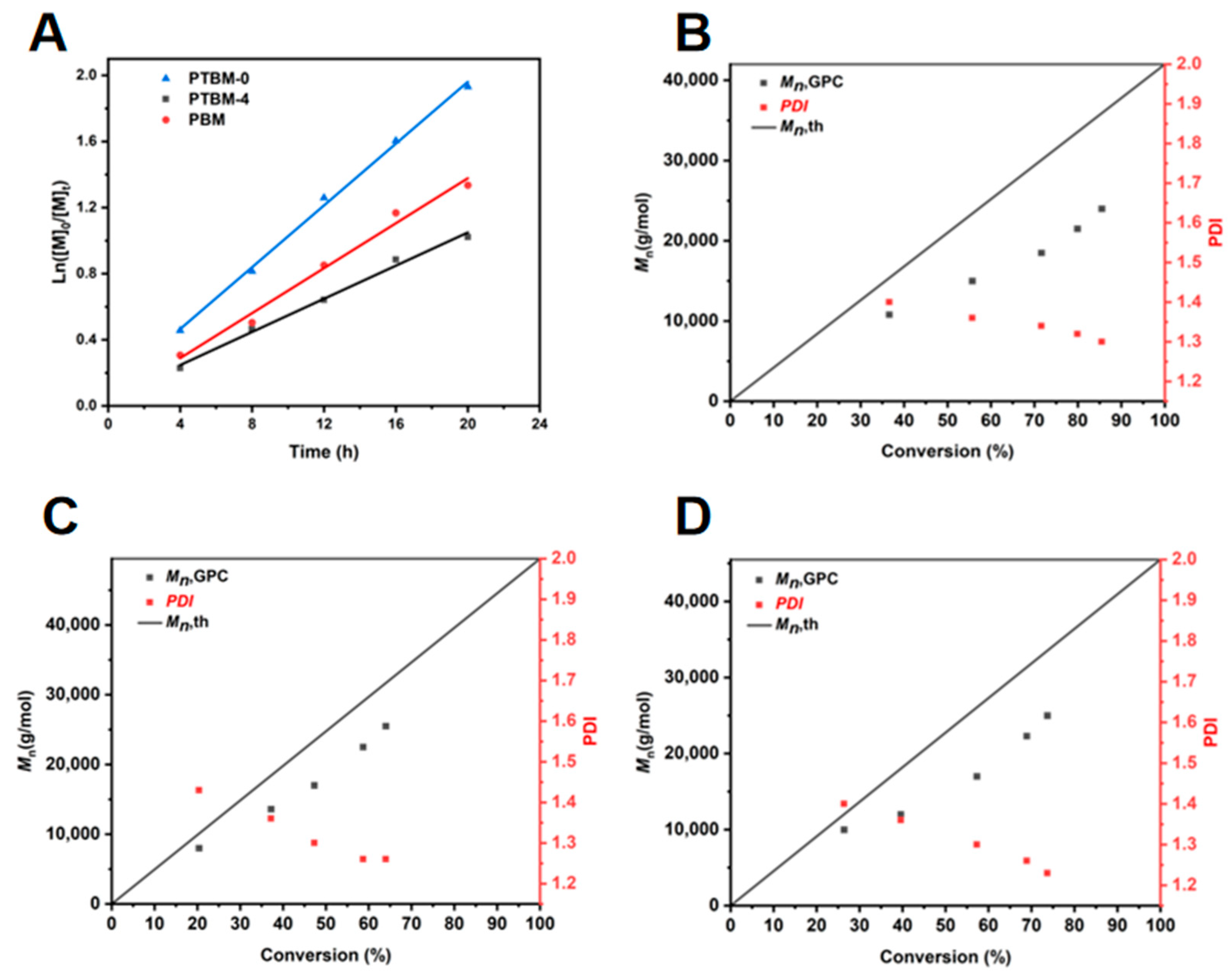
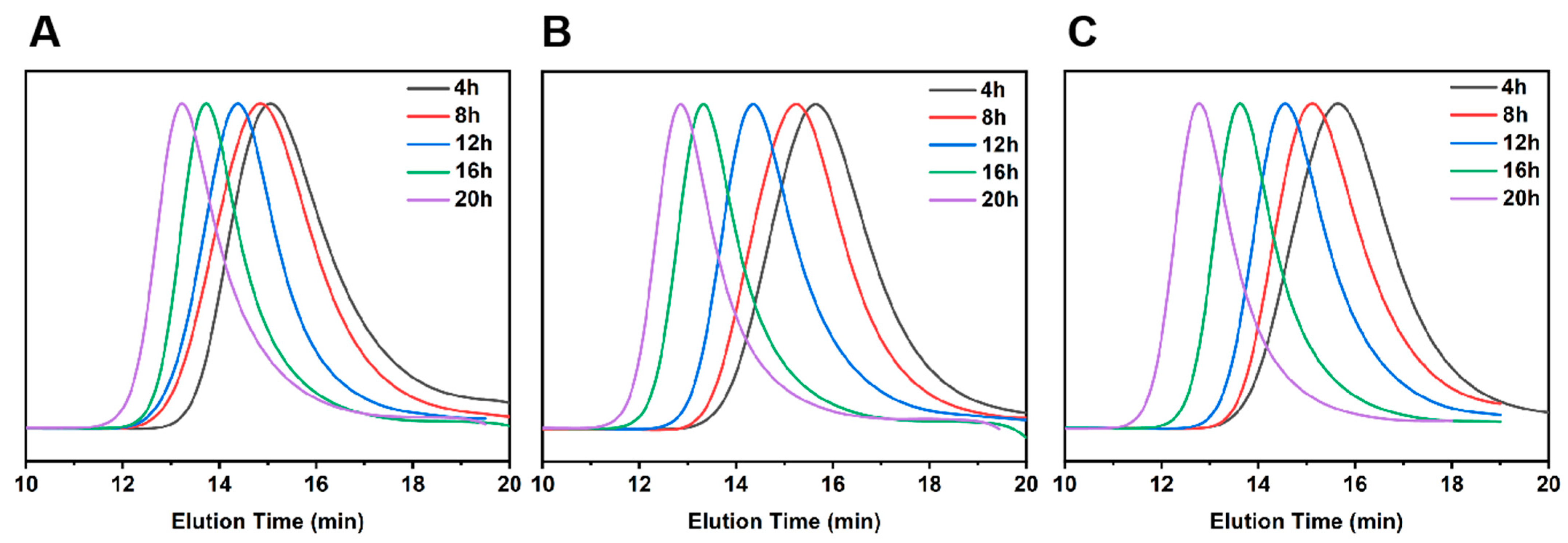
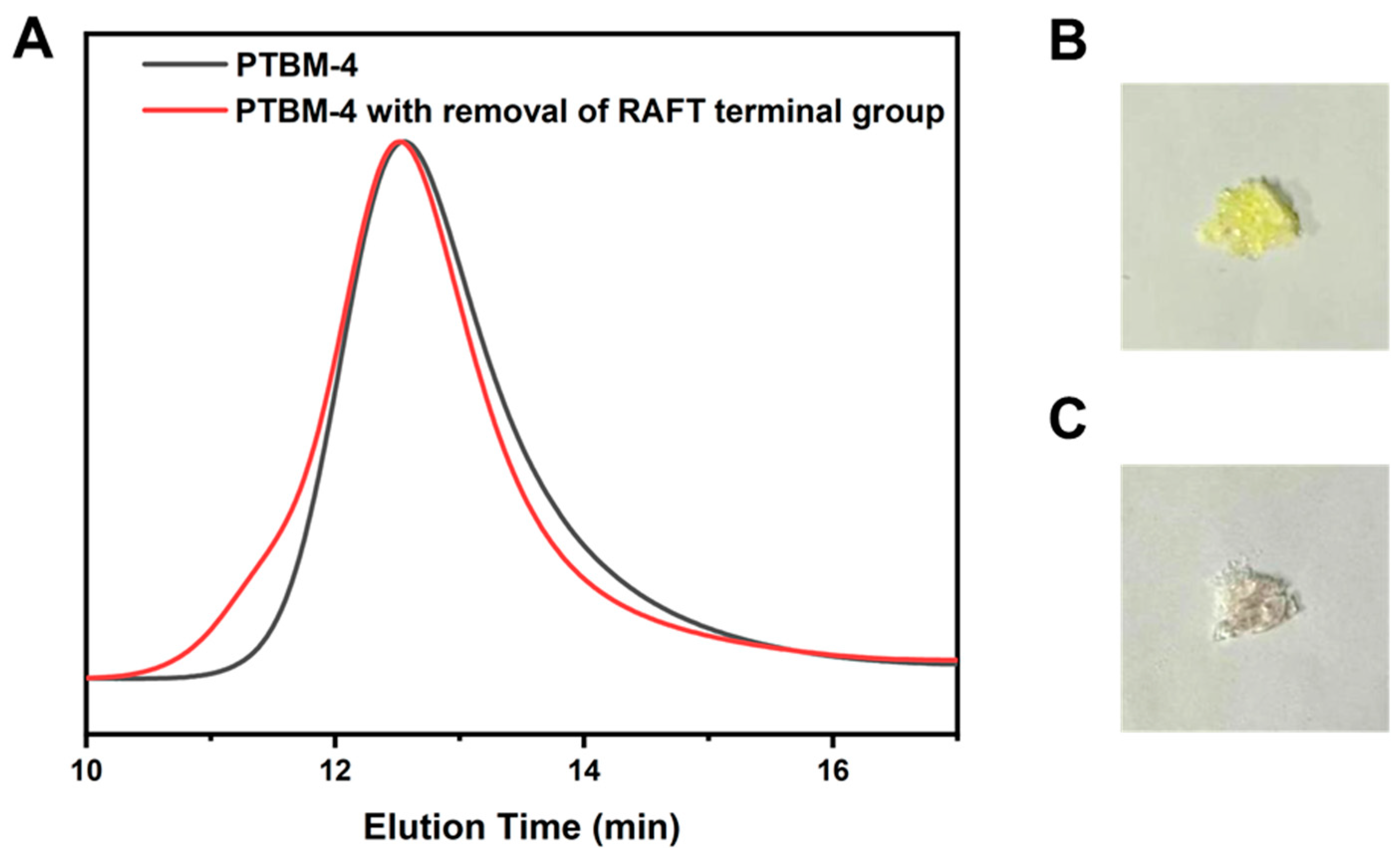

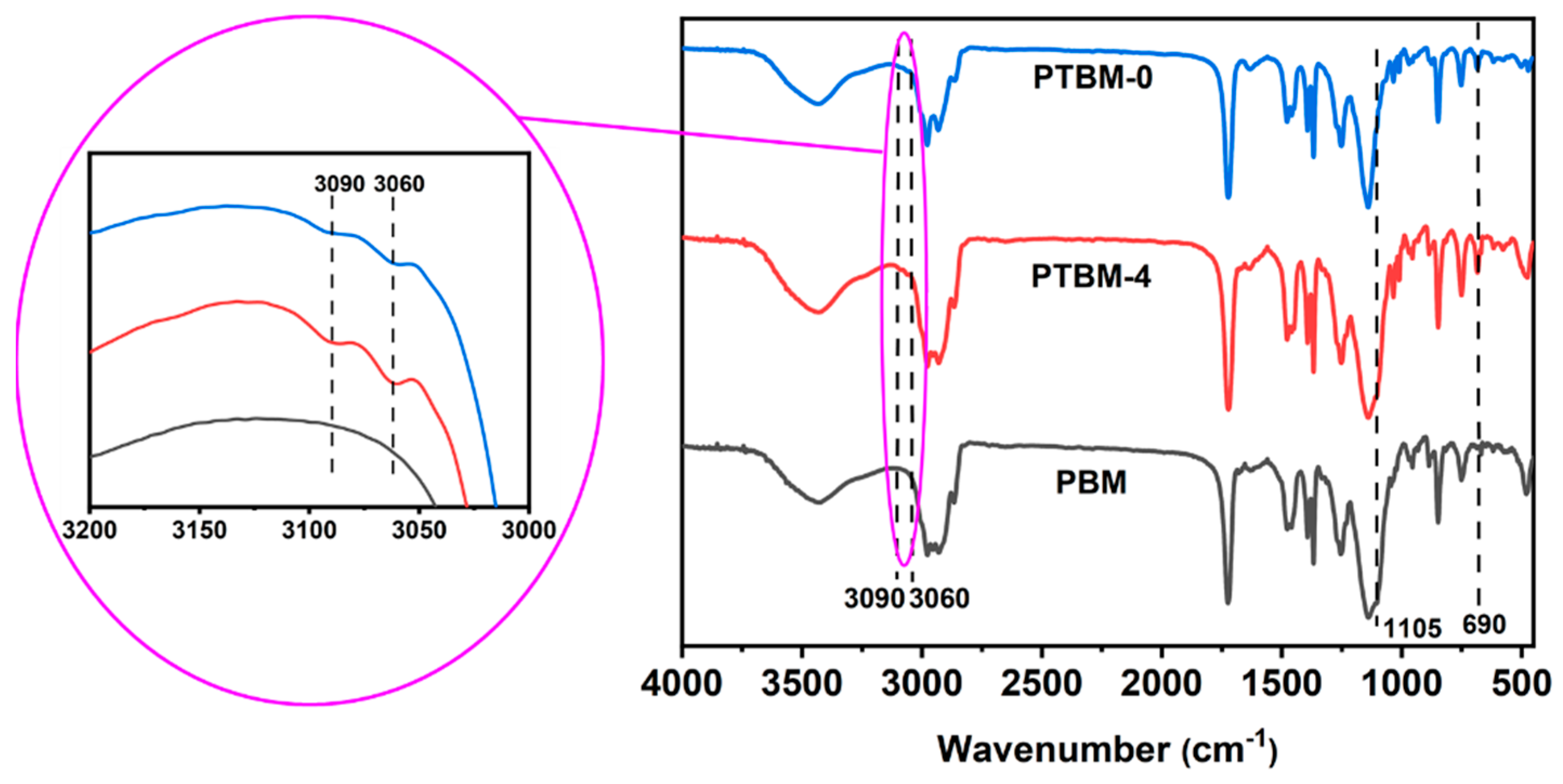
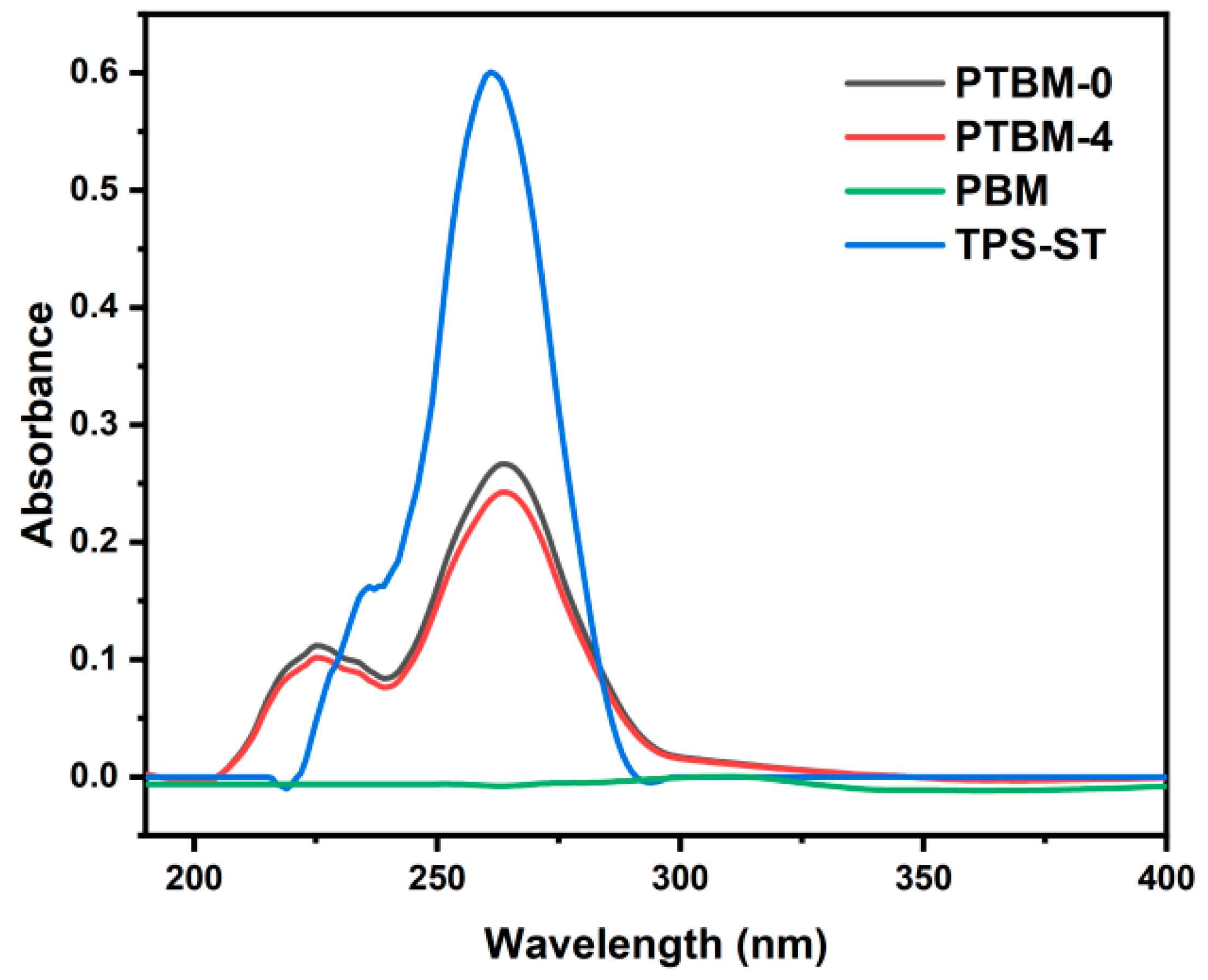
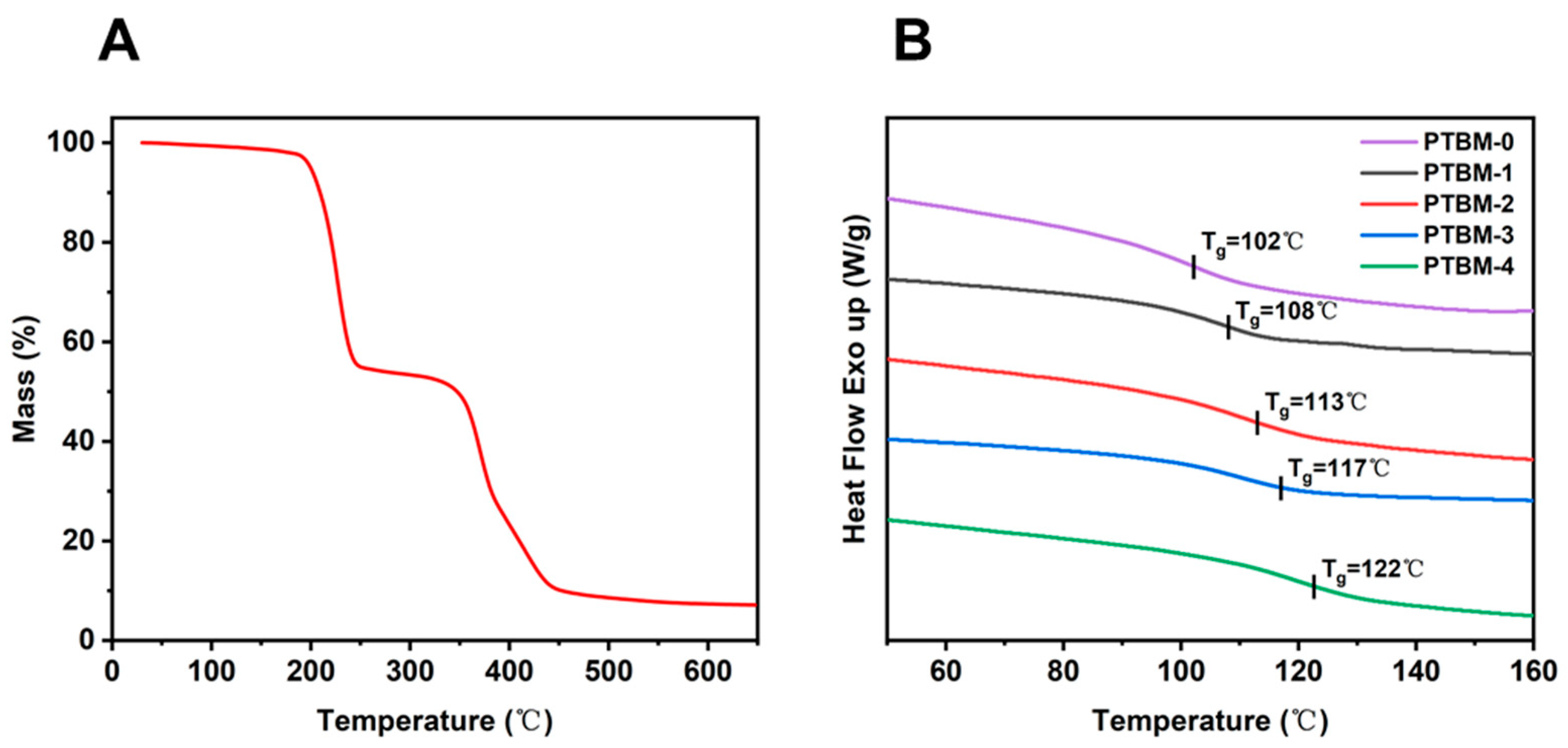
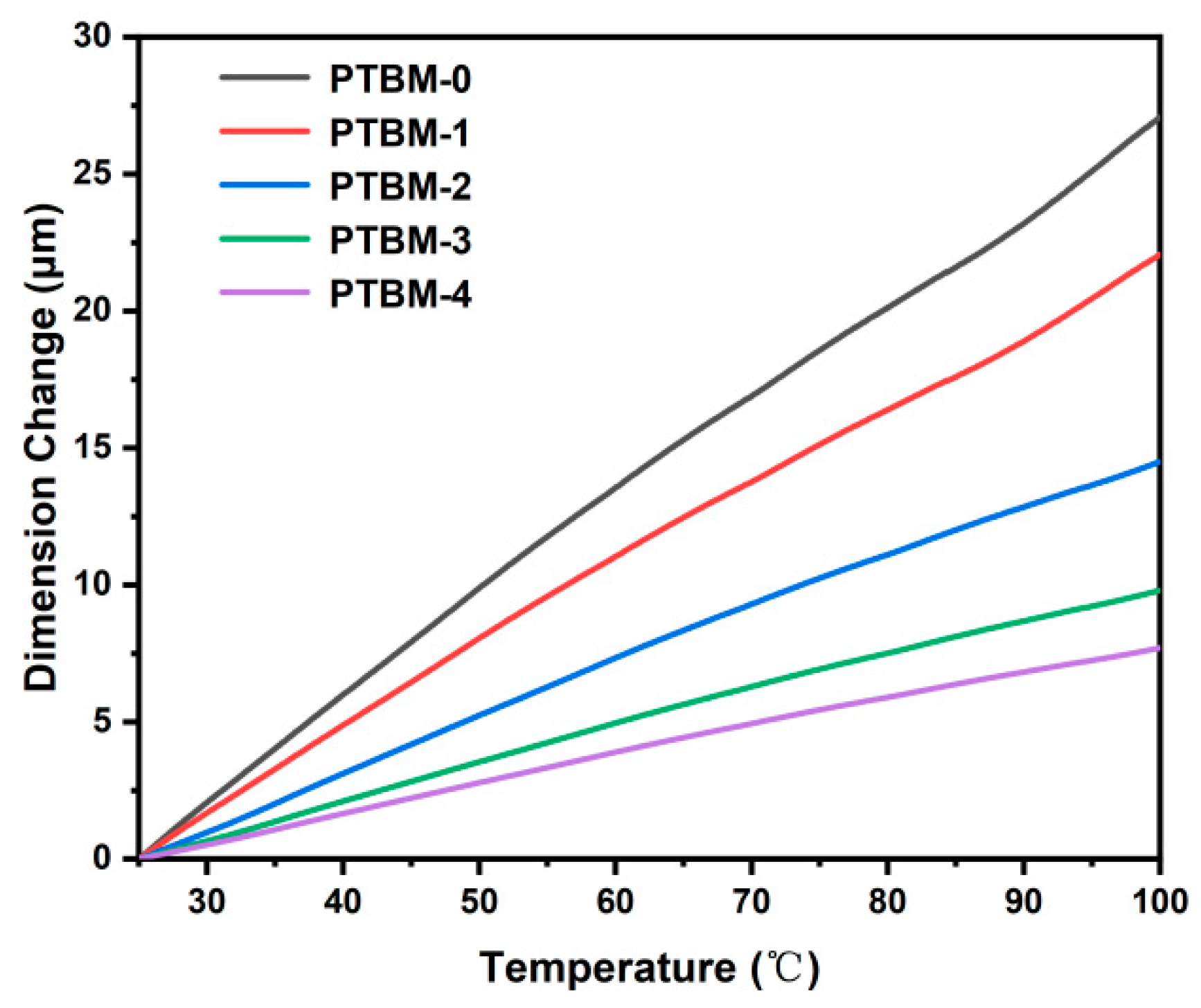
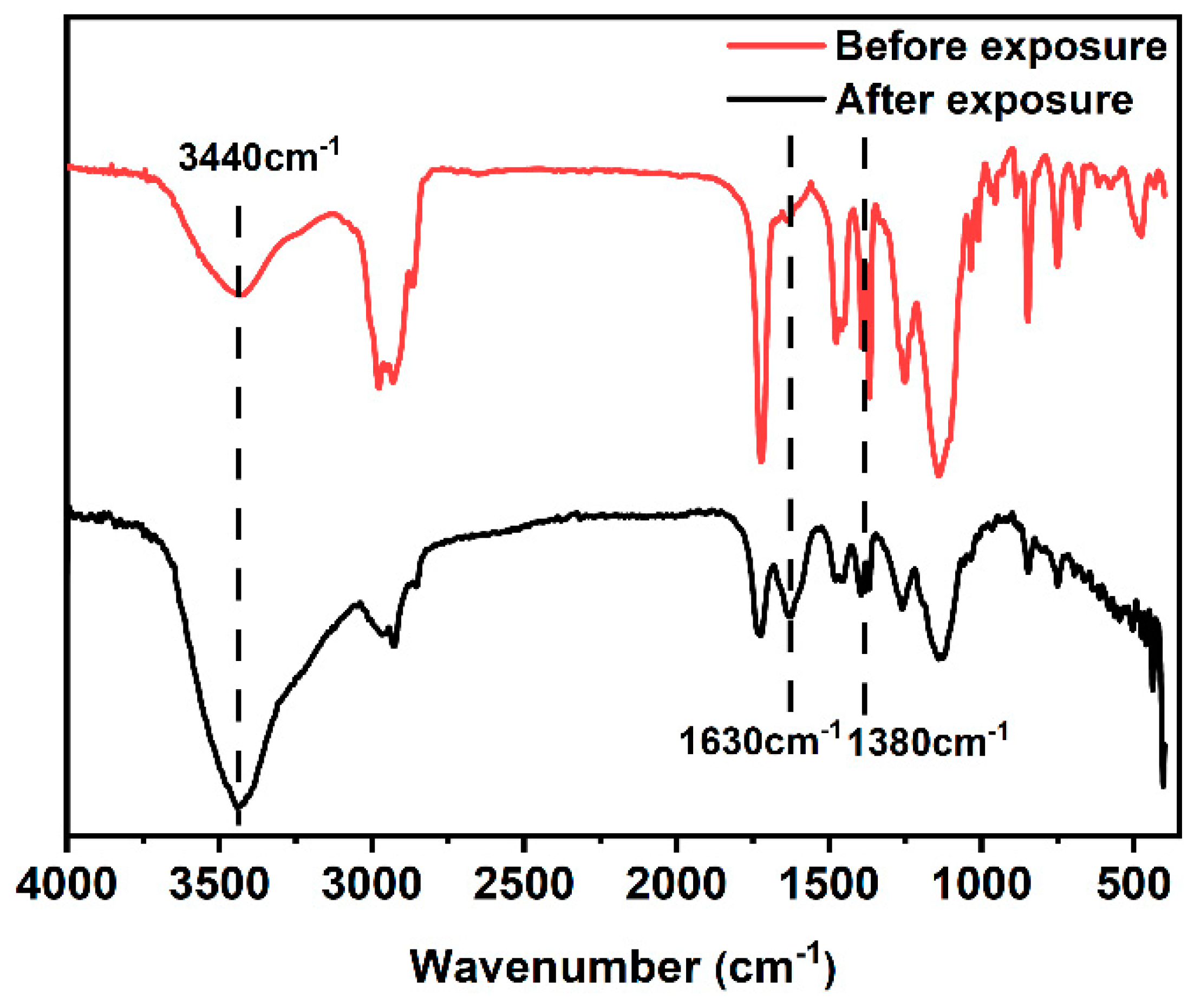
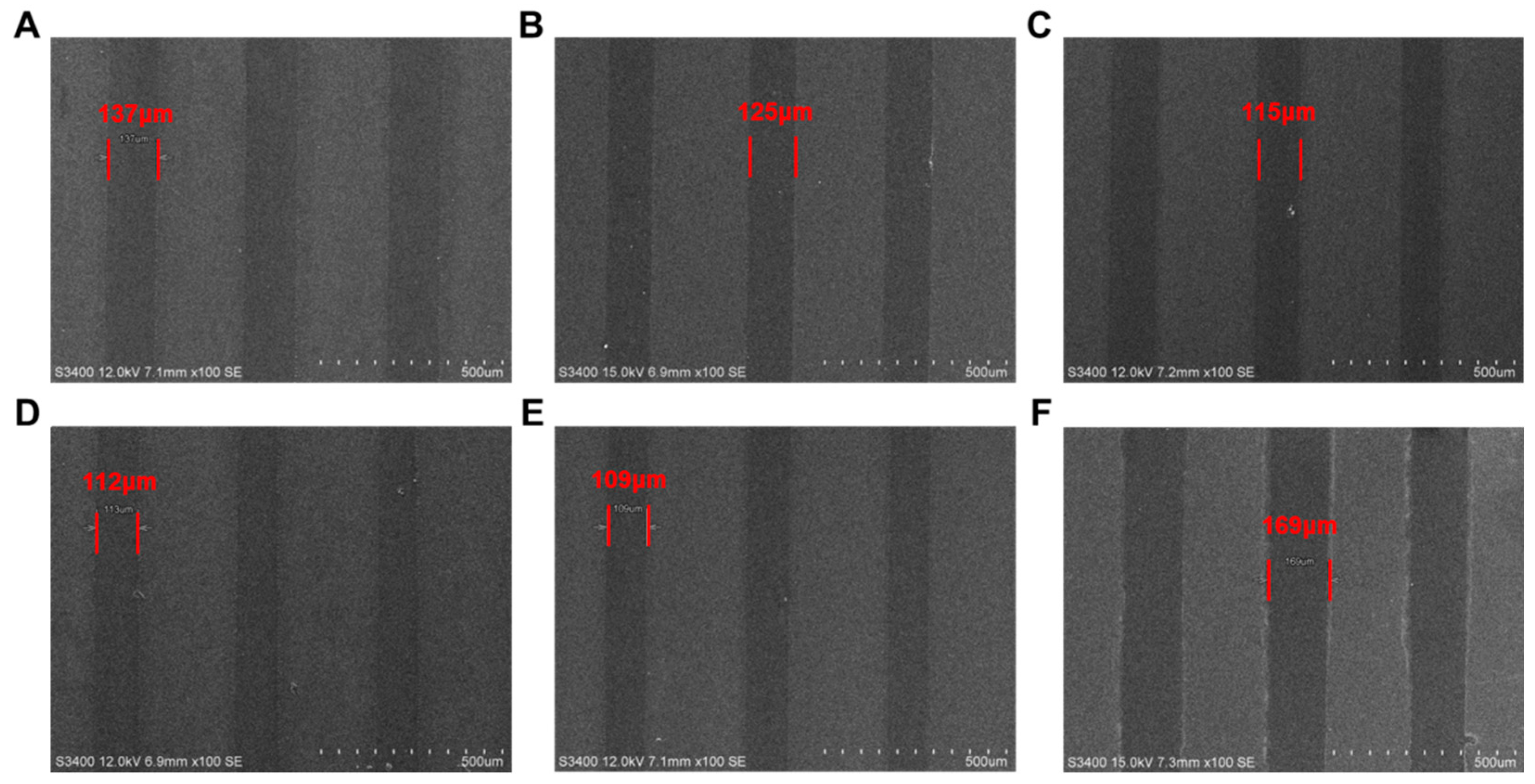
| Entry | [POSS-MA]:[TPS-SS]:[tBMA]:[MMA]:[CDSPA]:[AIBN] (a), (b) | Time (h) | A (c) (%) | Mn,GPC (kg·mol−1) (d) | Mn,th (kg·mol−1) (e) | Mw/Mn (d) |
|---|---|---|---|---|---|---|
| PTBM-0 | 0:8:200:100:1:0.5 | 20 | 85.5 | 24.0 | 35.9 | 1.29 |
| PTBM-1 | 2:8:200:100:1:0.5 | 20 | 81.3 | 24.4 | 35.7 | 1.28 |
| PTBM-2 | 4:8:200:100:1:0.5 | 20 | 75.6 | 24.9 | 34.6 | 1.25 |
| PTBM-3 | 6:8:200:100:1:0.5 | 20 | 70.2 | 25.1 | 33.4 | 1.27 |
| PTBM-4 | 8:8:200:100:1:0.5 | 20 | 64.0 | 25.5 | 31.7 | 1.26 |
| PBM | 8:0:200:100:1:0.5 | 20 | 73.7 | 25.0 | 33.5 | 1.23 |
| N (%) | C (%) | H (%) | S (%) | |
|---|---|---|---|---|
| PTBM-4 | 0.23 | 66.22 | 8.667 | 1.749 |
| PTBM-4 without RAFT terminal group | 0.18 | 64.90 | 8.624 | 1.324 |
| Entry | Feed Ratio (mol%) | Copolymer Compositions (a) (mol%) | ||||||
|---|---|---|---|---|---|---|---|---|
| [POSS-MA] | [TPS-SS] | [tBMA] | [MMA] | [POSS-MA] | [TPS-SS] | [tBMA] | [MMA] | |
| PTBM-0 | 0 | 2.6 | 64.9 | 32.5 | 0 | 2.8 | 61.1 | 36.1 |
| PTBM-1 | 0.6 | 2.6 | 64.5 | 32.3 | 0.7 | 2.9 | 61.0 | 35.4 |
| PTBM-2 | 1.3 | 2.6 | 64.1 | 32.0 | 1.3 | 2.9 | 61.1 | 34.7 |
| PTBM-3 | 1.9 | 2.6 | 63.7 | 31.8 | 2.0 | 2.7 | 60.4 | 34.9 |
| PTBM-4 | 2.6 | 2.6 | 63.3 | 31.5 | 2.8 | 2.6 | 64.4 | 30.2 |
| PBM | 2.6 | 0 | 64.9 | 32.5 | 2.7 | 0 | 63.9 | 33.4 |
Disclaimer/Publisher’s Note: The statements, opinions and data contained in all publications are solely those of the individual author(s) and contributor(s) and not of MDPI and/or the editor(s). MDPI and/or the editor(s) disclaim responsibility for any injury to people or property resulting from any ideas, methods, instructions or products referred to in the content. |
© 2024 by the authors. Licensee MDPI, Basel, Switzerland. This article is an open access article distributed under the terms and conditions of the Creative Commons Attribution (CC BY) license (https://creativecommons.org/licenses/by/4.0/).
Share and Cite
Yu, H.; Liu, S.; Fu, H.; Cui, Z.; Zhang, L.; Tian, J. POSS and PAG Dual-Containing Chemically Amplified Photoresists by RAFT Polymerization for Enhanced Thermal Performance and Acid Diffusion Inhibition. Appl. Sci. 2024, 14, 7722. https://doi.org/10.3390/app14177722
Yu H, Liu S, Fu H, Cui Z, Zhang L, Tian J. POSS and PAG Dual-Containing Chemically Amplified Photoresists by RAFT Polymerization for Enhanced Thermal Performance and Acid Diffusion Inhibition. Applied Sciences. 2024; 14(17):7722. https://doi.org/10.3390/app14177722
Chicago/Turabian StyleYu, Haimeng, Shaoshuai Liu, Haiyan Fu, Zepeng Cui, Liangshun Zhang, and Jia Tian. 2024. "POSS and PAG Dual-Containing Chemically Amplified Photoresists by RAFT Polymerization for Enhanced Thermal Performance and Acid Diffusion Inhibition" Applied Sciences 14, no. 17: 7722. https://doi.org/10.3390/app14177722





